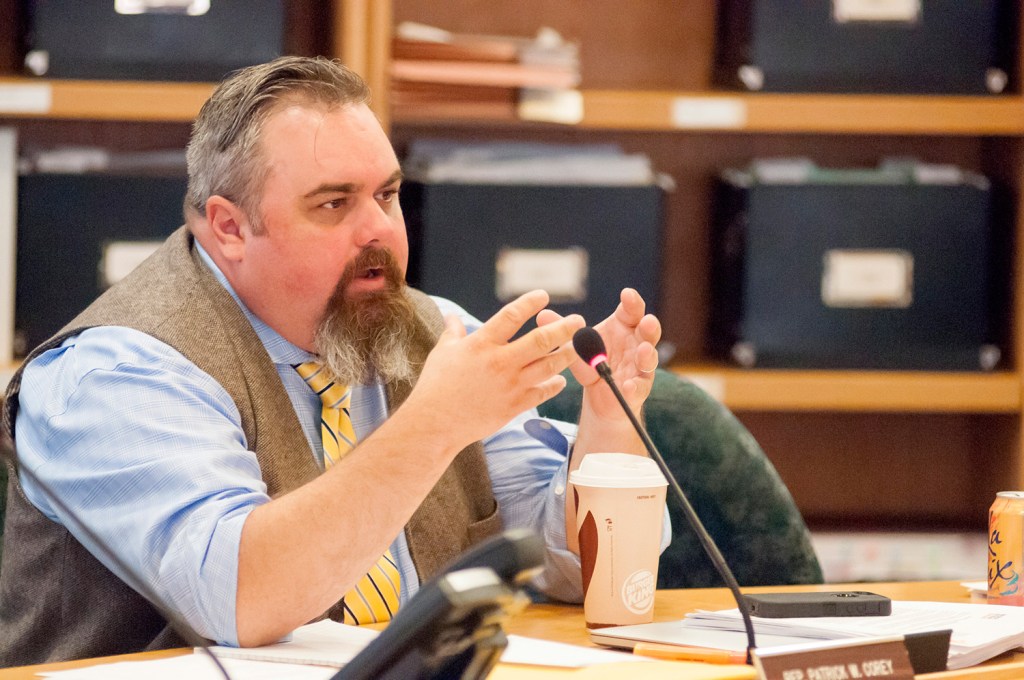A Republican lawmaker who proposed legislation seeking a $20 million bond to fund state-specified school safety improvements developed the bill in concert with the Sportsman’s Alliance of Maine. The hunting and fishing organization rarely involves itself with school issues but is a fierce opponent of most gun control legislation.
“Funding is really the biggest obstacle to security enhancements at Maine’s K-12 public schools. I strongly believe the Department of Education and the Department of Public Safety are in the best positions to determine these needs,” said Rep. Patrick Corey, R-Windham, who proposed the legislation. “I feel a real sense of immediacy, as I know many Mainers do, but without the funding in place very little can happen.”
Corey’s bill comes on the heels of a mass shooting that claimed 17 lives at a Florida high school.
The proposal will go before the Legislative Council on Tuesday, Corey said in a media release. The council is made up of the 10 members of legislative leadership, including the Senate president and the House speaker, and its approval is needed for any bill filed after the deadline to be considered.
The $20 million would be distributed on a matching-fund basis for local school districts, which could raise their half through private donations if needed, Corey said.
The Department of Education would have to collaborate with the Department of Public Safety and other state and federal agencies in determining appropriate safety measures, he said. A spokeswoman for the Department of Education said Monday that the department would not comment on proposed legislation.
Currently, schools use a variety of funding sources for school safety improvements. Many took advantage of federal funding that was available in the wake of the 2012 Sandy Hook Elementary School shooting to make security upgrades.
Corey’s bill would have the bond money administered through the Department of Education’s School Revolving Renovation Fund, which is a loan program that schools currently use for improvements and repairs.
Districts can apply for up to $1 million per school building for projects that, generally speaking, are too big to cover with the usual facility maintenance budget, but short of the major school renovation and replacement fund administered by the state Board of Education. Safety improvements get the highest priority for approval.
The department ranks and prioritizes the projects, groups them into one list, and the Maine Municipal Bond Bank obtains a bond that covers all the approved projects, thus saving the districts money if they had tried to finance the projects on their own. Between 30 percent and 70 percent of each loan is considered a grant and forgiven, and the remaining balance is paid back interest-free over a five- or 10-year period. Those repayments cycle back to help pay for other approved projects.
Those same terms would apply to districts applying for funds from the new $20 million that would be earmarked for safety improvements, said David Trahan, director of the Sportsman’s Alliance of Maine.
“Our organization is proud to introduce legislation that, unlike other proposals coming forward in recent days, will actually make our schools a safer place to learn,” said Trahan, a former Maine legislator. “This bill will make major investments in modern technology and proven security upgrades to protect Maine teachers, support staff and students at all times and in all situations.”
Trahan said the Feb. 14 shooting deaths of 17 people at Marjory Stoneman Douglas High School in Parkland, Florida, have sparked a range of proposals from banning bump stocks to arming teachers. He said they are proposing the bond because it is a practical approach.
“Our organization wants to look at policies that you know are going to make schools safer,” he said.
By law, Maine school districts already have comprehensive emergency plans, hold regular lockdown drills and review security plans with school boards every year. Security protocols vary depending on the school district, the type of school and, in some cases, the year in which a school was built. Newer schools tend to have more built-in safety measures.
Specific security measures are confidential, but many schools adopted similar measures, such as adding video and buzzer systems to all school entryways, adding specialized door locks operated with electronic swipe cards, trimming vegetation to improve sight lines, and painting numbers at school entry/exit doors on the outside of buildings to assist emergency personnel if they respond to an incident.
There are several bills tabled from the last legislative session that would add $20 million to $50 million over two years to the revolving renovation fund. In testimony, Acting Deputy Education Commissioner Suzan Beaudoin said the department recognized the need to replenish the fund, which is down to about $1 million, and planned to bring forward its own bond request to the Appropriations Committee when it takes up all proposed General Fund bond legislation.
The Appropriations Committee has at least $500 million in bond requests before it, and less than $150 million in the current state budget for paying the debt service on borrowing.
Also this session, the Legislature is considering a bill that would allow people picking up or dropping off students at schools to have unloaded guns in their vehicles. In public testimony, school officials vigorously opposed it, saying that any gun spotted on campus would trigger a lockdown and emergency response.
Noel K. Gallagher can be contacted at 791-6387 or at:
Twitter: noelinmaine
Send questions/comments to the editors.




Comments are no longer available on this story